mu Boo (**)
|
| Name: |
mu Boo, 51 Boo, Alkalurops |
| Type: |
** |
| Constellation: |
Boo |
| Coordinates: |
15h24m29.54s / +37°22'37.10" |
| Components: |
|
|
m1 |
m2 |
ρ |
θ |
Year |
| CHR181, mu 1 Boo |
Aa-Ab |
4m.3 |
- |
0.1" |
188° |
2012 |
| STFA28, mu 1 Boo |
AB |
4m.3 |
7m.1 |
109.2" |
170° |
2023 |
| STF1938, mu 2 Boo |
Ba-Bb |
7m.1 |
7m.6 |
2.3" |
2° |
2023 |
|
|
|
|
|
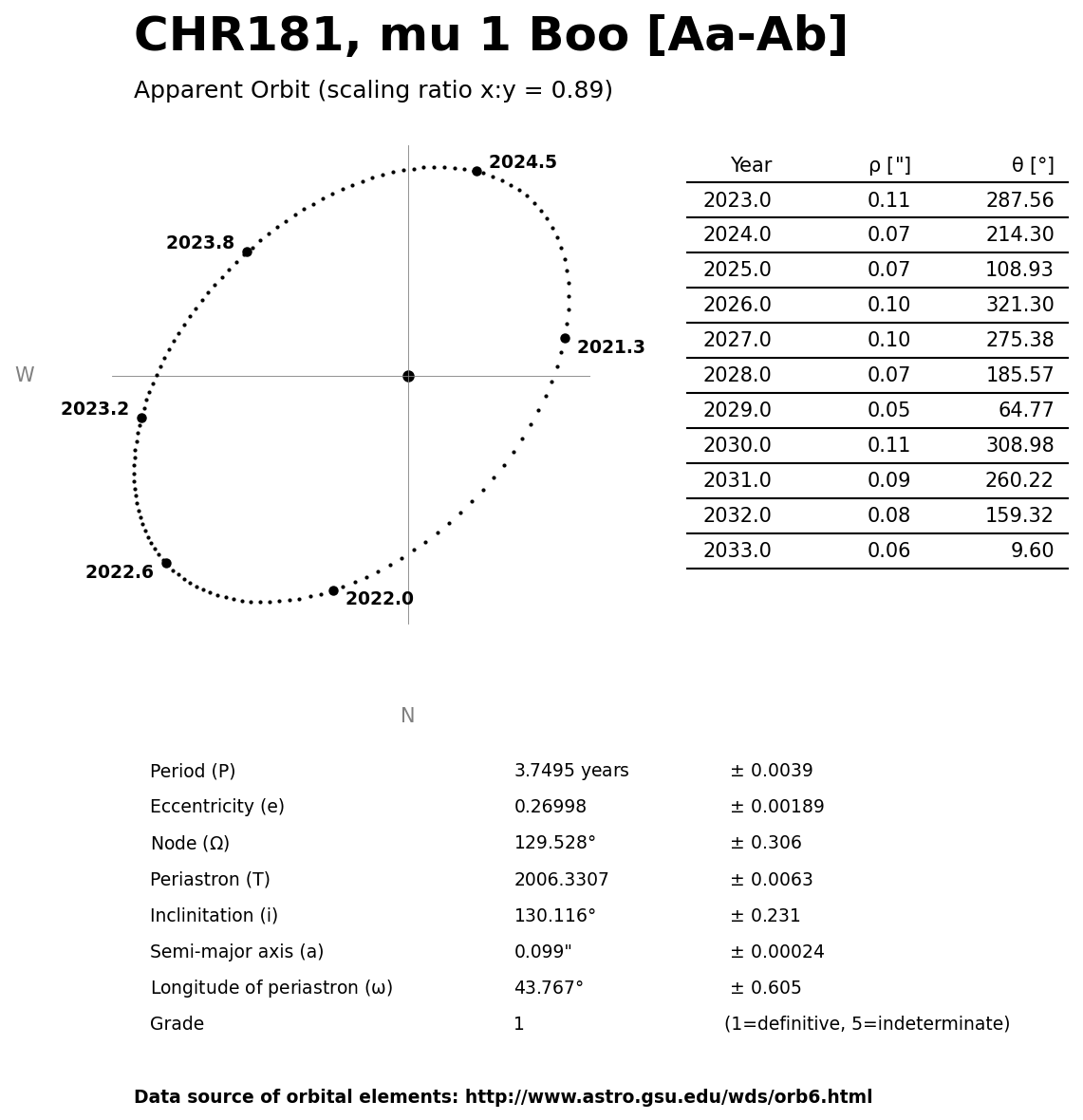
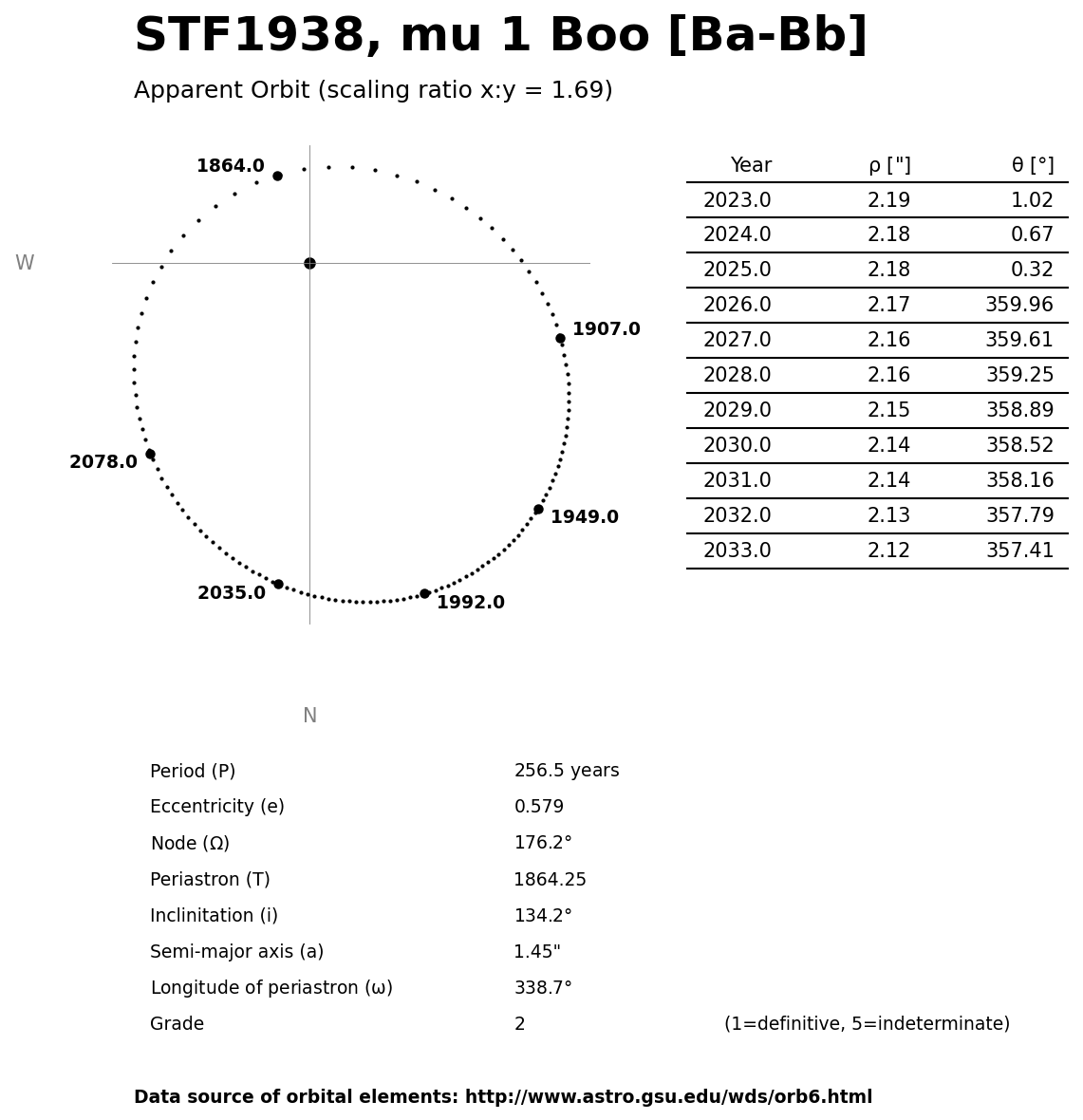
|
|
| Robert Zebahl |
102mm f/11, 125x, Bortle 6-, SQM-L 19.2
Beautiful view! This triple system includes STFA 28 and STF 1938.
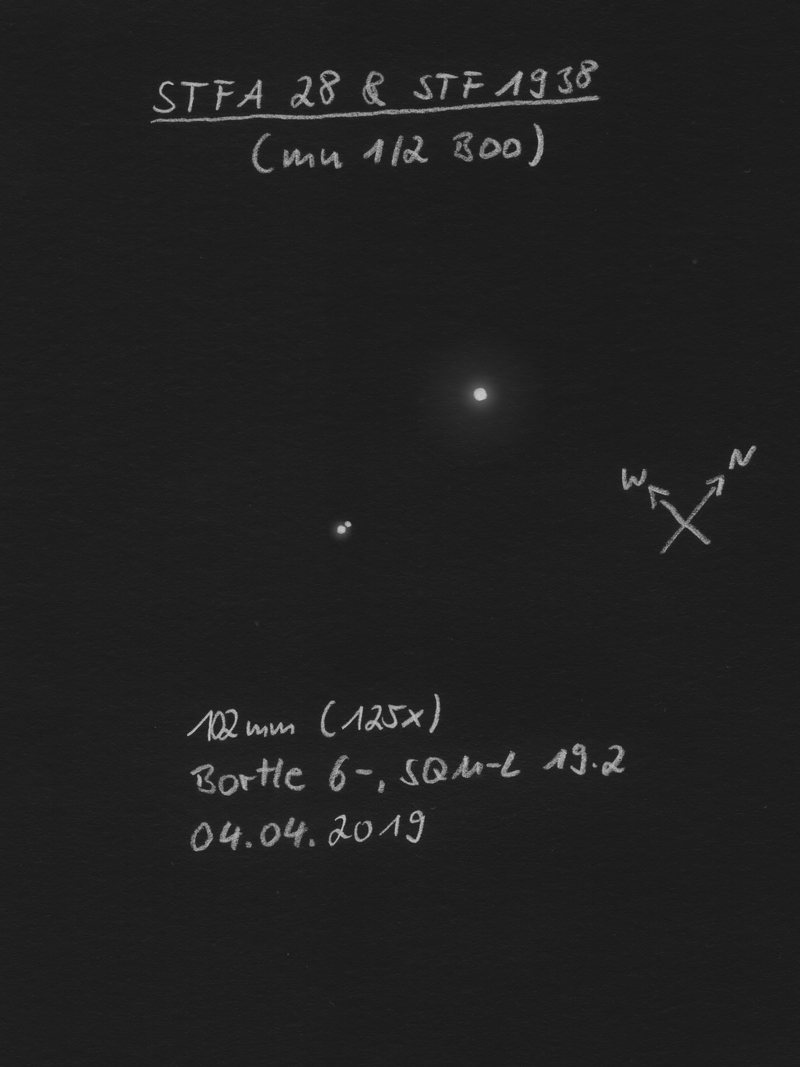
|
|
B 8x40, Bortle 7, NELM 5m.0, SQM-L 19.2
STFA28 (AB): Easily split with obvious difference in brightness.
|
|
B 16x70, Bortle 6
STFA28 (AB): 2021-06-14: Wide, relatively striking pair. Pale yellow & dark orange.
|
|
70mm f/5.7, 22x, Bortle 6, SQM-L 19.2
STFA28 (AB): Evident, very wide apart and unequal. A: white-yellowish, B: grey.
|
|
120mm f/5, 23x, Bortle 6, NELM 5m.0+, SQM-L 19.4
STFA28 (AB): Easy to split with large angular distance and noticeable difference in brightness.
|
|
| René Merting |
B 16x70, SQM-L 21.0
STFA28 (AB): weit getrenntes Pärchen, aufgrund der großen Helligkeitsunterschiedes schöner Farbkontrast - Komponente A im Norden gelblich, B im Süden mehr grau-braun
|
|
107mm f/5.6, 30x, SQM-L 20.2
STFA28 (AB): AB: das Paar ist bei 30x komfortabel getrennt erkennbar, A strahlt leicht gelblich - Komponente B besteht aus zwei Sternen Ba, Bb (STF 1938), die ab 120x getrennt zu sehen sind - Bb im Norden ist gut eine viertel bis halbe Größenklasse schwächer als Ba
|
|
107mm f/5.6, 120x, SQM-L 20.7
STF1938 (Ba-Bb): bei 86x ist nördlich von Ba ein zweiter etwas schwächerer Stern erkennbar, er klebt noch an Ba - 120x reichen dann für eine knappe Trennung - Bb im Norden ist eine viertel bis halbe Größenklasse schwächer
|
|
|
Picot 1 (Ast)
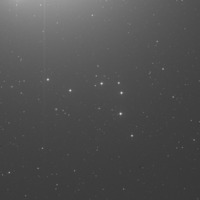
Image source: DSS II (blue) - 40'×40'
|
| Name: |
Picot 1, Napoleon's Hat |
| Type: |
Ast |
| Constellation: |
Boo |
| Coordinates: |
14h14m55.00s / +18°33'00.00" |
| Brightness / Size: |
- / 20.0'×7.0' |
|
|
|
|
|

|
|
| Robert Zebahl |
B 16x70, Bortle 6, SQM-L 19.4
Pretty prominent star pattern, which indeed can be interpreted as a hat. The brim of the hat towards southwest appears shortened due to a fainter star. I tend to see a small mountain here. All in all a quite attractive star pattern.
|
EASY
|
| René Merting |
B 10x50, SQM-L 21.3
Napoleons Hut - mit geduldiger Beobachtung wird indirekt der obere Teil des Hutes und die Spitze erkennbar - das Filigrane an diesem SM gefällt mir
|
MODERATE
|
B 18x70, SQM-L 21.3
eine schöne zarte, wellenförmige Linie von 7 relativ gleich schwachen Sternen
|
EASY
|
100mm f/6.4, 49x, SQM-L 21.3
bei 49x sind 6 der 7 Sterne auszumachen, der siebte ist indirekt sichtbar - für den perfekten Hut fehlt mir noch ein Stern am Südende
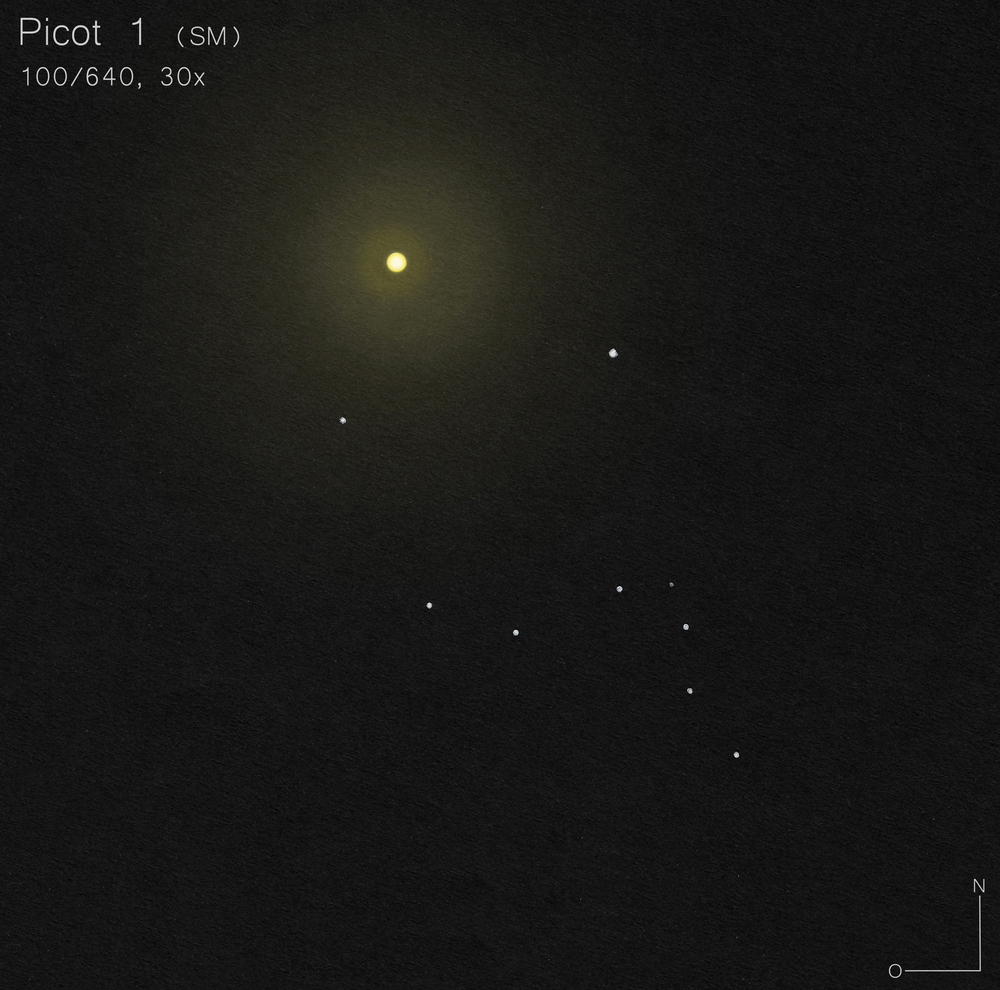
|
EASY
|
12.5" f/4.5, 72x, SQM-L 21.3
hier fällt auf, dass im Umfeld nicht viel mehr Sterne, als in kleinen Öffnungen sichtbar, dazu kommen, das Muster steht ziemlich allein - der Gedanke an eine Made, die zum gelbgoldenen Apfel Arktur robbt, gefällt mir besser als der Hut
|
EASY
|
|
STF 1877 (**)
|
| Name: |
STF1877, epsilon Boo, Izar |
| Type: |
** |
| Constellation: |
Boo |
| Coordinates: |
14h44m59.14s / +27°04'29.90" |
| Components: |
|
|
m1 |
m2 |
ρ |
θ |
Year |
|
AB |
2m.6 |
4m.8 |
3.0" |
347° |
2023 |
|
| Robert Zebahl |
55mm f/9.1, 125x
The fainter component was seen as permanent brightening on the first diffraction ring of the primary component.
|
|
60mm f/10, 192x, Bortle 6-, SQM-L 19.1
Easy to split, whereby the much fainter component lies on the first diffraction ring of the primary component. The primary component itself appeared slightly yellowish.
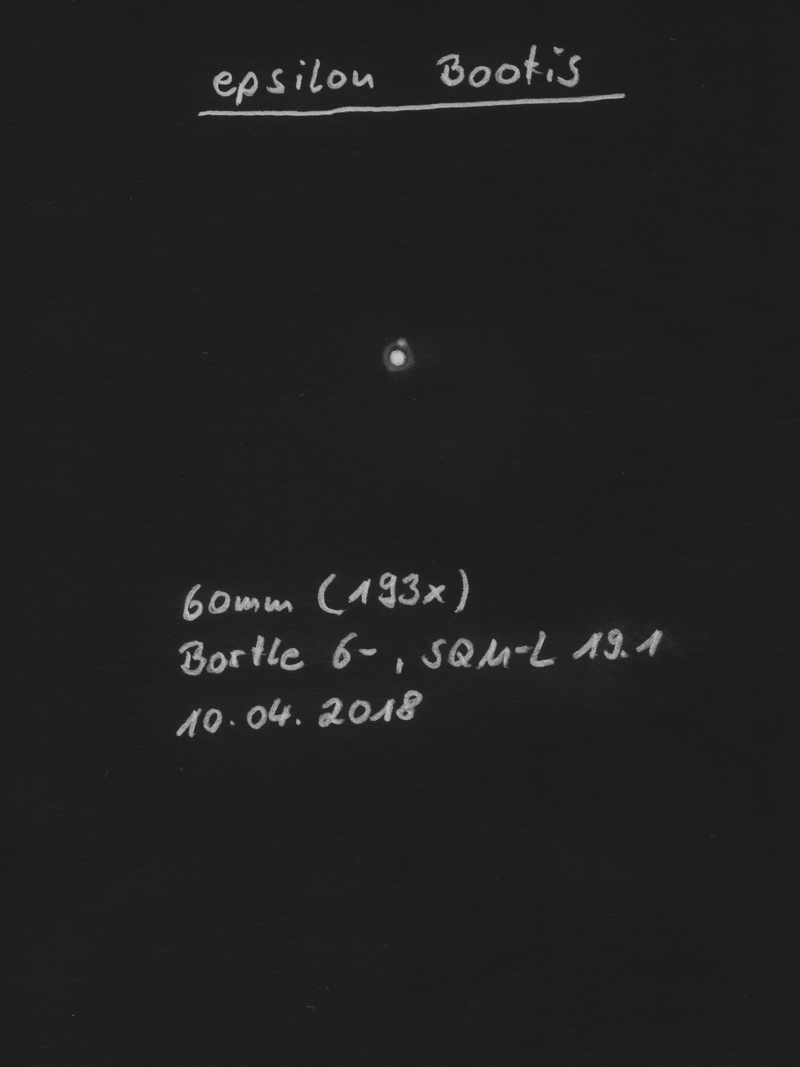
|
|
70mm f/5.7, 133x, Bortle 6, SQM-L 19.2
Easy to split, very unequal. A appeared in pale orange, B was visible as a very tiny, grey star on the first diffraction ring of component A.
|
|
102mm f/11, 224x
2021-05-12: Primary component appears in bright orange, the well separated, much fainter companion at 187x grey-bluish, at 224x and higher in a very nice, pale blue.
|
|
120mm f/5, 192x, Bortle 4, SQM-L 21.3
At 85x the fainter component was easily visible but not separated. At 192x well split. The fainter component was almost on the first diffraction ring of the primary component. Quite big difference in brightness. I did not looked at the color of the components.
|
|
| René Merting |
100mm f/6.4, 142x, SQM-L 21.0
bei 107x erscheint die B-Komponente nordwestlich leicht angesetzt an der gelblich strahlenden Komponente A - bei 142x dann ist die Trennung komplett, B liegt schön auf einem abgesetzten Beugungskranz von Komponente A
|
|
107mm f/5.6, 120x, SQM-L 20.6
bei 120x gelingt die Trennung - die B-Komponente im Norden ist mindestens 2 Magnituden schwächer - A strahlt schön Gelbweiß, B ist Aschegrau
|
|
|






